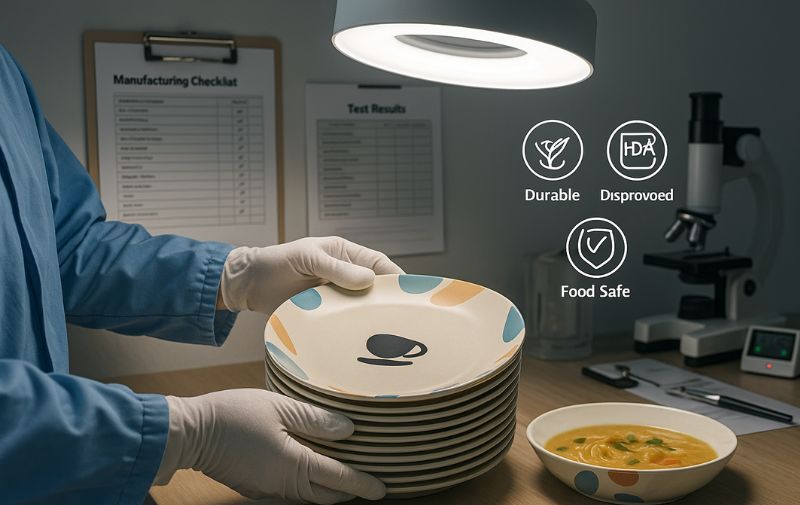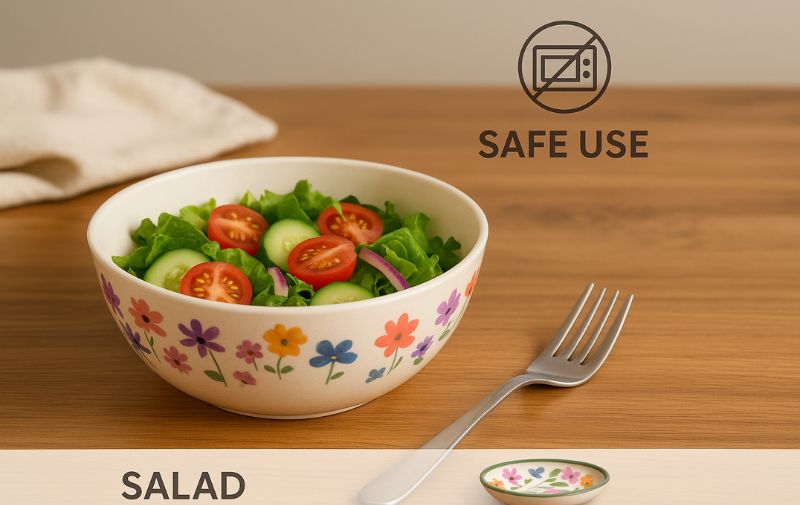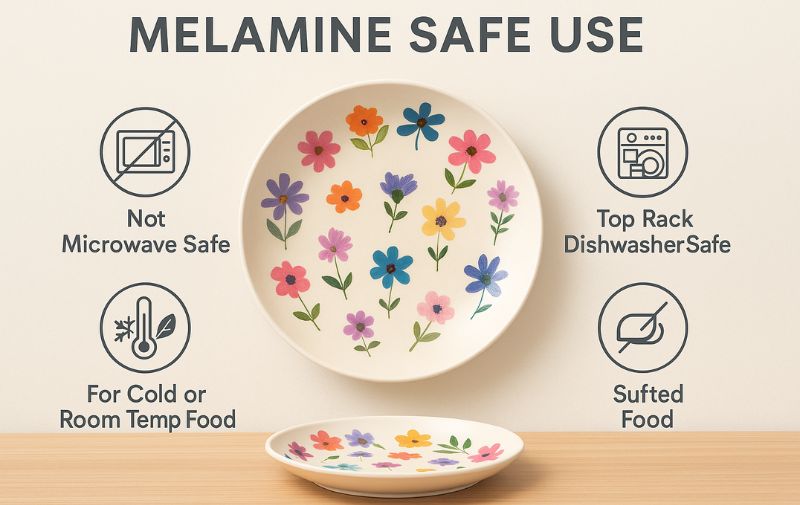Worried if your melamine plates are toxic? You’re not alone. The key concern isn’t the plate itself, but potential “melamine leaching” – tiny amounts of the chemical melamine migrating into food, especially with misuse. High-quality A5 melamine plates safety is generally good when used correctly (no microwaving!). This guide uncovers the truth, helping you understand the risks and ensure safe dining.
Last Updated: May 2025 | Estimated Reading Time: 12 minutes

What Exactly is Melamine and How Could it Be a Concern in Plates? 🤔
Understanding the basics is crucial when discussing melamine plates safety.
What is the chemical melamine, and how can exposure occur through kitchenware like plates?
Melamine is an organic-based chemical primarily used to produce melamine-formaldehyde resin, a very durable thermosetting plastic. This resin is what your melamine plates are made of.
- For you: Exposure can occur if tiny amounts of melamine “migrate” or leach from the plate into your food. This isn’t about the solid plate being poisonous to touch.
- Industry Insider Tip: “Food-grade” A5 melamine is formulated to be highly stable. The goal of manufacturers and regulators (like Health Canada, which proposes measures to reduce dietary exposure) is to ensure any melamine leaching is well below established safe limits during normal use.
Why is melamine toxicity considered a significant health concern when contamination levels are high?
High levels of melamine ingestion can lead to serious kidney problems, including the formation of crystals or stones, potentially causing kidney damage or failure.
- For you: While typical use of quality dinnerware doesn’t lead to high contamination, understanding the potential if safety limits were drastically exceeded (like in past food adulteration incidents, not tableware use) highlights why regulations exist. This is a key aspect of assessing if are melamine dishes harmful under worst-case scenarios.
What Are the Potential Health Risks if Melamine from Plates Enters Your Body? 😟
If melamine were to enter your body in significant amounts, specific health issues could arise.
If melamine levels exceed safe limits, what serious health issues could individuals face?
The primary concern is kidney damage. Melamine, when ingested in high quantities, can crystallize in the kidneys.
- For you: This could lead to kidney stones and, in severe cases, acute kidney injury or renal failure. This risk is associated with high levels of exposure, far beyond what’s expected from proper use of food-grade melamine tableware.
- Health Risk Detail: This was tragically seen in incidents of intentional melamine contamination in food to boost protein content, not from standard dinnerware use.
How does the body handle melamine, and why might it lead to kidney stones or kidney damage?
Melamine is not easily broken down or metabolized by the body. If ingested, it tends to pass through the kidneys relatively unchanged.
- For you: At low levels (within safe limits from properly used tableware), this isn’t usually an issue. However, if higher concentrations are present in the kidneys, melamine can combine with other substances like cyanuric acid (if also present) to form insoluble crystals. These crystals can block kidney tubules, leading to melamine kidney stones and damage.
Can chronic exposure to melamine, even from dinnerware, contribute to problems like renal failure or reproductive toxicity?
Chronic exposure to high levels of melamine could theoretically contribute to ongoing kidney problems. The link to reproductive toxicity is less clear and often studied in contexts of higher industrial exposure, not typical dinnerware use.
Regulatory limits are set to protect against such chronic effects from dietary sources like tableware. Adhering to safe use practices is key to minimizing any melamine health risk.
📊 Melamine Exposure & Potential Kidney Impact 📊
| Exposure Level | How Body Handles | Potential Kidney Impact (if limits exceeded) ⚠️ | Your Best Defense ✅ |
|---|---|---|---|
| Low (Normal Use) | Passes through kidneys, excreted. | Minimal risk, within safe limits. | Use A5 grade plates, follow care instructions. |
| High (Misuse/Contamination) | Can overwhelm kidneys, potential for crystallization. | Kidney stones, kidney damage, renal failure. | NEVER microwave, avoid damaged/low-grade plates. |

Do Melamine Plates Actually Leach Harmful Substances into Food? 🍽️
This is the core question for many: is melamine leaching a significant issue with your plates?
What did the FDA’s safety assessment find regarding melamine migration from tableware into food under normal use?
The U.S. Food and Drug Administration (FDA) has studied melamine migration and found that the levels migrating from melamine tableware into food are generally very low and well within safe limits under conditions of normal use.
- This means when you use your melamine plates as intended (serving food, not cooking in them), the FDA melamine plates assessment suggests they are safe.
- Industry Pain Point: The phrase “normal use” is critical. Consumers often misunderstand what constitutes “abnormal use” that could increase migration.
Under what specific circumstances does the FDA suggest that using melamine dinnerware could be risky?
The FDA and other health authorities highlight specific scenarios where risk increases:
- 🔥 Microwaving: NEVER microwave melamine plates. Melamine absorbs microwave energy, can overheat, break down, and significantly increase the migration of melamine and formaldehyde into food. This is the cardinal sin and where melamine plates safety is most compromised.
- ♨️ Acidic Foods + High Heat (Prolonged): While A5 melamine is resistant, serving or storing very hot, highly acidic foods (e.g., lemon juice, tomato sauce-based dishes) in melamine for extended periods (many hours) could theoretically increase migration.
- Industry Perspective: For typical meal durations, this isn’t considered a significant risk with high-quality A5 melamine. The concern is more with long-term storage of hot, acidic items.
- Industry Perspective: For typical meal durations, this isn’t considered a significant risk with high-quality A5 melamine. The concern is more with long-term storage of hot, acidic items.
- 📉 Low-Quality or Damaged Plates:
- Insider Tip: Not all melamine is equal. “A5 melamine” is 100% food-grade resin. Lower grades (A1, A3, or those with excessive urea/fillers) are less stable and pose a higher migration risk. Reputable manufacturers like Duramela use A5. Heavily scratched or chipped plates should also be discarded as damage can increase leaching.
- Insider Tip: Not all melamine is equal. “A5 melamine” is 100% food-grade resin. Lower grades (A1, A3, or those with excessive urea/fillers) are less stable and pose a higher migration risk. Reputable manufacturers like Duramela use A5. Heavily scratched or chipped plates should also be discarded as damage can increase leaching.
Are Certain People More Vulnerable to Melamine’s Potential Effects?
Yes, some groups may be more susceptible.
Which groups, such as children or pregnant women, might be more susceptible to adverse effects from melamine exposure?
Infants and young children are generally considered more vulnerable due to their lower body weight, developing organs, and potentially higher food intake per kilogram of body weight. Pregnant women are also often considered a sensitive subpopulation for any chemical exposure. Individuals with pre-existing kidney conditions would also be at greater risk.
- This underscores the importance of using certified, high-quality A5 melamine dinnerware, especially for children, and strictly adhering to safe use practices.
- Cost Consideration (Indirect): Investing in certified A5 melamine safe for food, especially for children, is a prudent choice. The peace of mind is invaluable.
How do factors like the level and duration of exposure impact the severity of health risks?
The dose makes the poison.
- Level of Exposure: Higher concentrations of melamine migrating into food lead to a greater risk.
- Duration of Exposure: Chronic (long-term) exposure to elevated levels is more concerning than occasional, low-level exposure.
- For you: Using quality plates correctly minimizes both the level and duration of any significant exposure.
What Do Health Authorities Say About the Safety of Melamine Dinnerware?
Regulatory bodies provide guidance based on scientific assessments.
Does the FDA generally consider melamine dinnerware safe for serving food based on their assessments?
Yes, the FDA generally considers melamine dinnerware safe for its intended use in serving food. Their assessments indicate that the amount of melamine that migrates into food from tableware, when used correctly, is typically well below levels that would cause harm.
- This reassurance is contingent on proper use – primarily avoiding the microwave and not using melamine for cooking or holding extremely hot, acidic foods for very long periods.

How do regulatory bodies establish safe limits for melamine, and what are the concerns if these are surpassed?
Regulatory bodies like the FDA establish a “Tolerable Daily Intake” (TDI) or “Provisional Tolerable Weekly Intake” (PTWI) for substances like melamine. These are estimates of the amount of a substance that can be ingested daily (or weekly) over a lifetime without appreciable health risk.
- Concern if Surpassed: If these safe limits are consistently surpassed, the risk of adverse health effects, primarily to the kidneys (as discussed earlier regarding melamine kidney stones and damage), increases.
- Using certified A5 melamine tableware as intended helps ensure your exposure stays far below these established safe limits.
📊 Safe vs. Unsafe Practices with Melamine Plates 📊
| Practice | Safety Status 🚦 | Why & Your Risk |
|---|---|---|
| ✅ Serving room temp/warm food | SAFE | Minimal migration, well within FDA limits for A5 grade. |
| ✅ Serving mildly acidic food (short duration) | SAFE | Typical meal duration poses little risk with A5 grade. |
| ✅ Washing in dishwasher (top rack, per mfr.) | SAFE | Designed for this; avoids harsh scrubbing that could damage. |
| 🚫 Microwaving Melamine Plates | UNSAFE | Heats plate, causes breakdown, significantly increases melamine leaching. 🚨 |
| 🚫 Using for cooking/baking | UNSAFE | Not designed for oven/stovetop heat; can damage plate & increase migration. |
| 🚫 Storing very hot, highly acidic food for hours | CAUTION | Potentially increases migration over extended time. Use glass/ceramic for storage. |
| 🚫 Using heavily scratched/chipped plates | CAUTION | Damage can compromise surface integrity, potentially increasing migration. |
| 🚫 Using low-grade/unspecified melamine | RISKY | Higher chance of instability and chemical migration. Stick to certified A5. |
How Can You Use Melamine Plates Safely and Minimize Any Potential Risks?
Empower yourself with knowledge for safe usage.
Based on FDA findings, what are the implied best practices for using melamine tableware safely?
The core message from the FDA and other health authorities translates to these best practices:
- No Microwaving, Ever: This is the golden rule.
- Choose Quality: Opt for A5 food-grade melamine from reputable manufacturers. Look for certifications (FDA compliant, LFGB, BPA-Free). Buying Tip: Duramela ensures its products are A5 and BPA-Free.
- Inspect Regularly: Discard any plates that are heavily scratched, chipped, or cracked.
- Avoid Extreme Heat: Don’t use melamine for cooking or place extremely hot items (e.g., straight from a blazing oven or skillet) directly onto them. They are for serving, not for cooking.
- Handle Acidic Foods Wisely: While fine for serving typical meals, avoid storing highly acidic foods in melamine for extended periods, especially if hot.
Are there specific conditions (e.g., high temperatures, acidic foods) that users should avoid to prevent increased melamine migration from plates?
Yes, to reiterate and clarify:
- High Temperatures (especially in microwave): This is the biggest factor for increased migration. Also, avoid using them to serve foods that are so hot they might damage the plate surface (well above typical serving temperatures).
- Highly Acidic Foods + Prolonged Contact + Heat: The combination can increase migration over time. For a normal meal, it’s fine. For storing leftover spaghetti sauce for days, use glass or ceramic.
📊 Melamine Safety Checklist for You 📊
| Checkpoint | Action for You | Why It Matters for Safety |
|---|---|---|
| 🏷️ Grade & Certification | Buy A5 grade, BPA-Free, FDA/LFGB compliant. | Ensures higher stability & lower migration risk. |
| 🚫 Microwave Use | NEVER put melamine in the microwave. | Prevents material breakdown & harmful leaching. |
| 🔥 Oven/Stovetop Use | Do NOT use for cooking or baking. | Not designed for high cooking heat. |
| 🍋 Hot, Acidic Food Storage | Avoid long-term storage; use glass/ceramic. | Minimizes potential migration over extended periods. |
| 🔪 Damage Check | Discard if heavily scratched, chipped, or cracked. | Damaged surfaces can increase leaching & harbor bacteria. |
| 🧼 Cleaning | Follow manufacturer’s instructions (often top-rack DW). | Gentle cleaning preserves plate integrity. |
| 👶 Kids’ Use | Extra diligence with A5 grade for children. | Children can be more vulnerable. |
Common Questions About Melamine Plate Safety
Q1: Is it true that all melamine plates release formaldehyde?
A1: Melamine-formaldehyde resin is what quality plates are made of. When manufactured and used correctly (especially A5 grade, no microwaving), any potential migration of formaldehyde or melamine is extremely low and within safe limits set by bodies like the FDA. Misuse, particularly microwaving, can increase this.
Q2: Are bamboo plates with melamine binder safer?
A2: Bamboo itself is natural, but the melamine binder used in many “bamboo” plates faces the same usage rules as pure melamine plates (e.g., no microwaving). The safety depends on the quality and stability of that melamine binder. Always check for food-grade certifications.
Q3: What are some melamine exposure symptoms I should watch for?
A3: Symptoms from acute high-level melamine exposure (unlikely from tableware alone) could include irritability, blood in urine, little or no urine, signs of kidney infection, or high blood pressure. If you have serious concerns, consult a healthcare professional. Normal use of A5 melamine tableware is not expected to cause such symptoms.
Q4: Are there any truly non-toxic plates or safe dinnerware materials as alternatives?
A4: Glass, high-quality ceramic (lead-free glaze), and stainless steel are generally considered very safe and inert materials for dinnerware. However, A5 melamine, used correctly, is also considered safe by regulatory bodies.
Summary: Are Melamine Plates Toxic? The Verdict
The question “Is melamine plates toxic?” doesn’t have a simple yes/no answer without context.
- High-quality A5 melamine plates, when used as intended (CRITICALLY: NO MICROWAVING), are generally considered safe by health authorities like the FDA. Potential melamine leaching is minimal and within safe limits.
- The risks primarily arise from:
- Misuse: Especially microwaving.
- Low-Quality Materials: Non-A5 grade or inadequately manufactured products.
- Damaged Plates: Heavily scratched or chipped items.
Your Action Plan for Safe Melamine Use: Always choose A5 food-grade melamine from reputable sources. Read and follow care instructions diligently – especially the “no microwave” rule. By doing so, you can confidently enjoy the durability and style of melamine dinnerware without undue concern about melamine health risks.
Recommended Links:
- The Risks of Lead, Cadmium, BPA, and Melamine Exposure – The Conscious Insider
- Wikipedia – Melamine Poisoning
- Are Melamine Plates Safe?



